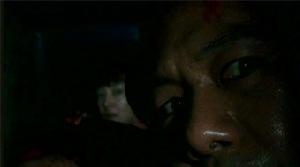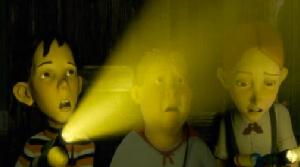
Shake, Rattle and Roll (Ishmael Bernal, Emmanuel Borlaza & Peque Gallaga, 1984)
Never mind Emmanuel Borlaza's episode entitled Baso (Glass), a tepid tale of a tragic love triangle ending in the spirits of the pre-Independence lovers crossing over to the modern world when three youngsters decide to perform a seance inside an abandoned estate using a glass vessel. Although interesting in some parts, Borlaza's forty minute contrubition is a downright embarrassment compared to the next two installments of this omnibus of horror shorts entitled Shake, Rattle and Roll.
Peque Gallaga's Manananggal (Monster) is the last portion of the omnibus. It opens with Douglas (Herbert Bautista) traveling the forest to court a barrio lass (Irma Alegre) who lives alone in the middle of the forest. Little does he know that the barrio lass is in fact a manananggal (a maiden who turns into a monster in the middle of the night --- the upper half of her body grows bat-like wings and separates from the lower half to hunt down probable victims) who takes the opportunity of Christ's death (the short film takes place during Holy Week) to wreak havoc to Douglas' family.
The story itself is quite bare. Uro dela Cruz's screenplay tries its best to create something compelling out of the folklore-inspired monstrosity. Yet the sparseness of the plot gives way for Gallaga to brandish his cinematic expertise. He overloads the film with atmospheric gravity which does not really help the plot, but merely expands the scenario --- creating a sense of Catholic impression to the old wives' tale. The afternoon of the manananggal's havoc-wreaking, Douglas goes to town and meets up with the actors of the passion play (Gallaga flavors the scene with the soundtrack of Jesus Christ Superstar playing on the background, the music coming from the town's store). Later on, during a brief seduction scene between Douglas and the suspect barrio lass, a man is shown flogging himself in repentance for his sins. There is really no direct connection between these Filipino Catholic traditions and the manananggal but the inclusion of some sort of local color helps create a distinct atmosphere for the feature.
The barrio lass' transformation to the bat-winged monster is an example of Gallaga's prowess in technique. There's a sense of seduction, of exotic allure in the lass' vulnerability during the transformation --- she oils her naked body and winces in what seems to be both pain and pleasure. Prosthetics and substandard special effects come to play, but Gallaga manages to still keep the believability factor intact with masterful editing and appropriate framing. Alas, Gallaga had to abruptly conclude the transformation with a laughable animated stand-in for the flying manananggal. The rest of Gallaga's film is Douglas defending his family against the manananggal's intentions --- filmed with adequate impression by Gallaga but the predictable ending betrays whatever atmosphere or squeezed-in depth Gallaga tried to infuse early on.
Shake, Rattle and Roll's middle and undoubtedly best portion is Ishmael Bernal's Pridyider (Frigidaire). It's also the silliest and most far-fetched of the bunch: Borlaza's Baso has history to back it up; Gallaga's Manananggal has folklore. Pridyider bases its horror from an inanimate object, a refrigerator (the Filipino term is gathered from the most popular brand of the home appliance) which has murderous and lustful intentions. A family moves into a house mysteriously left vacant for a number of years. The family is composed of the stern matriarch (Charito Solis), the beautiful daughter and target of most sexual intentions (Janice de Belen), the household help, and the stuttering distant male relative (William Martinez) who was asked to accompany the family of mostly females by the father who is working in the Middle East.
Bernal has a competent hold of the wild concept. The refrigerator remains immobile for most of the film (except for the occasional door swings and shakes --- just to make sure that the inanimate has some sort of mobility) yet despite that, holds considerable power. First and foremost, the refrigerator has become an appliance of necessity and second, because of the unbearable heat, the appliance has garnered a sort of seductive and sensual quality. When one is made uncomfortable by a gush of heat wave, one can't help but stand near the opened doors of the refrigerator --- a metaphorical exposing of oneself to temptations.
Mysterious things start happening. The mother starts seeing chopped human parts inside the refrigerator. Things get more gruesome as one by one, people are getting killed. As the police enters the scene, Pridyider starts failing with the threat of a possible need for a logical explanation to the refrigerator's evil deeds. Indeed, Pridyider does give a rational story behind everything which somehow lessens the haunting impact of the film (I won't be as scared of my ice box since I bought mine brand new --- I'm assured that there won't be evil spirits of butchering rapists invading this appliance). Yet Bernal does come up with scenes that just makes you forgive that one glaring mistake of rationalizing the hauntingly mysterious: the atmosphere of freely-flowing pheromones within the house (the distant relative makes love to the loose household help, the refrigerator itself moans and breathes deeply whenever the daughter is nearby like it were masturbating hidingly, the slow sexual awakening of the daughter with her boyfriend's prodding to devirginize her), the immobile yet ultimately shocking final horror set piece (wherein the daughter is first seduced to the icy coolness of the appliance, and then violently devoured).



.jpg)






















































